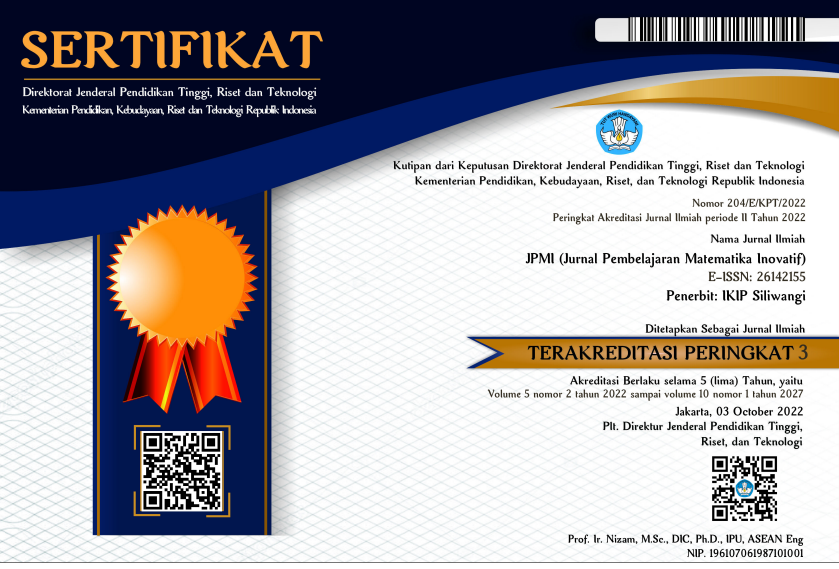ANALISIS SOAL DALAM BUKU MATEMATIKA KELAS VII SEMESTER 1 BERDASARKAN KRITERIA DARI HIGHER ORDER THINKING SKILLS (HOTS)
DOI:
https://doi.org/10.22460/jpmi.v4i4.p777-788Keywords:
Teks Book, HOTSAbstract
References
Anderson, L. W., & Krathwohl, D. R. (2001). A Taxonomy for Learning Teaching and Assessing: A Revision of Bloom’s Taxonomy of Educational Objectives. https://www.uky.edu/~rsand1/china2018/texts/Anderson-Krathwohl - A taxonomy for learning teaching and assessing.pdf
Anisah, A., & Azizah, E. N. (2016). Pengaruh Penggunaan Buku Teks Pelajaran dan Internet sebagai Sumber Belajar terhadap Hasil Belajar Siswa pada Pembelajaran IPS. Jurnal Logika, 18(3), 1–18. http://jurnal.unswagati.ac.id/index.php/logika/article/viewFile/215/138
Fajriatin, A. (2015). Analisis Buku Siswa Matematika Kurikulum 2013 Kelas IX Bab Sistem Persamaan Linear Dua Variabel Berdasarkan Konten Pada Kriteria Bell. Jurnal Pendidikan Matematika UNY, ISBN. 978-02-73403-0-5, 71–76.
Giani, Zulkardi, Hiltrimartin, C. (2012). Analisis Tingkat Kognitif Soal-Soal Buku Teks Matematika Kelas VII Berdasarkan Taksonomi Bloom. 1.
Hadi, S., & Novaliyosi. (2019). TIMSS Indonesia (Trends in International Mathematics and Science Study). Prosiding Seminar Nasional & Call For Papers Program Studi Magister Pendidikan Matematika Universitas Siliwangi, 562–569.
Hafid, H. A. (2011). Sumber dan Media Pembelajaran. Jurnal Sulesana, 6(2), 69–78. journal.uin-alauddin.ac.id
Jailani, M. sahran, & Hamid, A. (2016). Pengembangan Sumber Belajar Berbasis Karakter Peserta Didik (Ikhtiar optimalisasi Proses Pembelajaran Pendidi-kan Agama Islam (PAI)). Nadwa, 10(2), 175. https://doi.org/10.21580/nw.2016.10.2.1284
Kusuma, A. P., & ’Adna, S. faith. (2021). Analisis Kesulitan Siswa dalam Menyelesaikan Soal Higher Order Thinking Skill (HOTS) Sistem Persamaan Linear Dua Variabel. Jurnal SAINTIKA UNPAM, 3(2), 150–160.
Maemunah, S., & Ramlah. (2019). Analisis buku teks siswa SMP kelas VIII pokok bahasan teorema pythagoras ditinjau dari taksonomi bloom. Prosiding Sesiomadika, 2(4), 903–922. https://www.google.com/url?sa=t&rct=j&q=&esrc=s&source=web&cd=1&ved=2ahUKEwjolfSu2IrpAhWf63MBHdhxDyEQFjAAegQIBRAB&url=https%3A%2F%2Fjournal.unsika.ac.id%2Findex.php%2Fsesiomadika%2Farticle%2Fdownload%2F2559%2F1941&usg=AOvVaw2b89D-xcoDg6F9mqeATowF
Permendiknas Nomor 22, Tahun 2006, tentang Standar Isi, 1 (2006).
OECD. (2019). Programme for international student assessment (PISA) results from PISA 2018. OECD, 1–10. https://www.oecd-ilibrary.org/education/pisa-2018-results-volume-iii_bd69f805-en%0Ahttps://www.oecd-ilibrary.org//sites/bd69f805-en/index.html?itemId=/content/component/bd69f805-en#fig86
Pratama, G. S. (2019). Analisis Muatan Higher Order Thinking Skills (HOTS) pada Buku Teks Matematika SMP (Komparasi Buku Indonesia dan Malaysia). Universitas Negeri Yogyakarta.
Siagian, R. E. F. (2015). Pengaruh Minat dan Kebiasaan Belajar Siswa terhadap Prestasi Belajar Matematika. 2(20), 122–131.
Sujana, I. W. C. (2019). Fungsi dan Tujuan Pendidikan. 4(April), 29–39.
Supriadi. (2015). Pemanfaatan Sumber Belajar dalam Proses Pembelajaran. 3(2).
Tanujaya, B. (2016). Development of an Instrument to Measure Higher Order Thinking Skills in Senior High School Mathematics Instruction. Journal of Education and Practice, 7(21), 144–148.
Wibowo, P. (2015). Analisis Tingkat Kognitif Latihan Soal Berdasarkan Taksonomi Bloom Pada Buku Teks Matematika SMP Kelas VIII Kurikulum 2013 [Universitas Jember]. http://repository.unej.ac.id/bitstream/handle/123456789/65672/Ainul Latifah-101810401034.pdf?sequence=1
Yenusi, T., Mumu, J., & Tanujaya, B. (2019). Analisis Soal Latihan Pada Buku Paket Matematika Sma Yang Bersesuaian Dengan Higher Order Thinking Skill. Journal of Honai Math, 2(1), 53–64. https://doi.org/10.30862/jhm.v2i1.58.

















